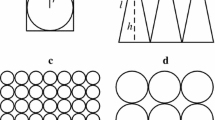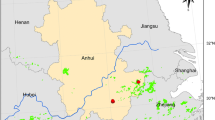Abstract
In this study, a geometric model of a growing forest stand has been explored. The basic relationships considered link stand volume and stand density, diameter at breast height (DBH), mean DBH and mean height. The model provides simple formulas connecting the exponents of all the relationships. Application of the formulas to real forestry data provided a high level of predictions of an exponent from two others measured through regressions from empirical data. The Pinus sylvestris L. data were of a static nature, a collection of individual stands, while the Pseudotsuga menziesii (Mirb.) Franco data were dynamic, representing forest stand development over time. The ability of the model to predict exponents in the empirical data implies, on the one hand, a substantial level of similarity between the model and the forestry data. And, on the other hand, the model gives an example in which parameters of one relationship may be linked to parameters of another. Supposedly this kind of ‘relationship between relationships’ may be observed in forest stands undergoing active growth and competition-induced self-thinning.








Similar content being viewed by others
References
Curtis RO, Marshall DD (2009a) Levels-of-growing-stock Cooperative Study in Douglas-fir: Report No. 19–the Iron Creek Study, 1966–2006. Research paper PNW-RP-580. U.S. Department of Agriculture, Forest Service, Pacific Northwest Research Station, Portland, OR
Curtis RO, Marshall DD (2009b) Levels-of-growing-stock Cooperative Study in Douglas-fir: Report No. 18-Rocky Brook, 1963–2006. Research report PNW-RP-578. U.S. Department of Agriculture, Forest Service, Pacific Northwest Research Station, Portland, OR
Frothingham EH (1914) White pine under forest management. Bull US Dep Agric 13:1–70
Gavrikov VL (2014) A simple theory to link bole surface area, stem density and average tree dimensions in a forest stand. Eur J For Res 133:1087–1094. https://doi.org/10.1007/s10342-014-0824-4
Gavrikov VL (2017) Stem surface area in modeling of forest stands. Springer, Cham. https://doi.org/10.1007/978-3-319-52449-8
Gavrikov VL (2018) ‘Relationships between relationships’ in forest stands: intercepts and exponents analyses. J For Res 29:575–582. https://doi.org/10.1007/s11676-017-0475-7
Henry HAL, Aarssen LW (1999) The interpretation of stem diameter–height allometry in trees: biomechanical constraints, neighbour effects, or biased regressions? Ecol Lett 2(2):89–97
Hilmi GF (1955) Bogeophysical theory and prognosis of forest self-thinning. Izd. AN SSSR, Moscow (in Russian)
Inoue A (2004) Relationships of stem surface area to other stem dimensions for Japanese cedar (Cryptomeria japonica D. Don) and Japanese cypress (Chamaecyparis obtusa Endl.) trees. J For Res 9(1):45–50
Inoue A (2009) Allometric model of the maximum size–density relationship between stem surface area and stand density. J For Res 14(5):268–275
King JE, Marshall DD, Bell JF (2002) Levels-of-growing-stock Cooperative Study in Douglas-fir: Report no. 17-the Skykomish Study, 1961-93; the Clemons Study, 1963–1994. Research paper PNW-RP-548. U.S. Department of Agriculture, Forest Service, Pacific Northwest Research Station, Portland, OR
Marshall DD, Curtis RO (2001) Levels-of-growing-stock cooperative study in Douglas-fir: Report no. 15-Hoskins: 1963-1998. Reseach paper PNW-RP-537. U.S. Department of Agriculture, Forest Service, Pacific Northwest Research Station, Portland, OR
Mohler CL, Marks PL, Sprugel DG (1978) Stand structure and allometry of trees during self-thinning of pure stands. J Ecol 66(2):599–614
Reineke LH (1933) Perfecting a stand-density index for even-aged forests. J Agric Res 46(7):627–638
Usoltsev VA (2010) Eurasian forest biomass and primary production data. Yekaterinburg: Ural Branch of Russian Academy of Sciences (in Russian)
Vanclay JK (2010) Robust relationships for simple plantation growth models based on sparse data. For Ecol Manag 259(5):1050–1054
Vanclay JK, Sands PJ (2009) Calibrating the self-thinning frontier. For Ecol Manag 259(1):81–85
Weller DE (1987) Self-thinning exponent correlated with allometric measures of plant geometry. Ecology 68(4):813–821
Weller DE (1989) The interspecific size–density relationship among crowded plant stands and its implications for the-3/2 power rule of self-thinning. Am Nat 133(1):20–41
Author information
Authors and Affiliations
Corresponding author
Additional information
Publisher's Note
Springer Nature remains neutral with regard to jurisdictional claims in published maps and institutional affiliations.
Project funding: This study was funded by the Russian Foundation for Basic Research, Government of Krasnoyarsk Territory, Krasnoyarsk Regional Fund of Science, under the research project: “Prognosis of region-specific responses of Siberian mountain forests to global environmental changes and of the landscape development trajectories for mitigation of environmental risks and an effective long-term planning in various economic sectors” (No. 18-45-240001), and by the Russian Foundation for Basic Research to the research project: “Late Holocene dynamics of Asia boreal forests at the background of changing geochemistry and climatic conditions” (No. 19-05-00091).
The online version is available at http:// www.springerlink.com.
Corresponding editor: Zhu Hong.
Electronic supplementary material
Below is the link to the electronic supplementary material.
Rights and permissions
About this article
Cite this article
Gavrikov, V.L. A theory to link relationships of stand volume, density, mean diameter and height in forestry data. J. For. Res. 32, 15–20 (2021). https://doi.org/10.1007/s11676-019-01077-7
Received:
Accepted:
Published:
Issue Date:
DOI: https://doi.org/10.1007/s11676-019-01077-7




